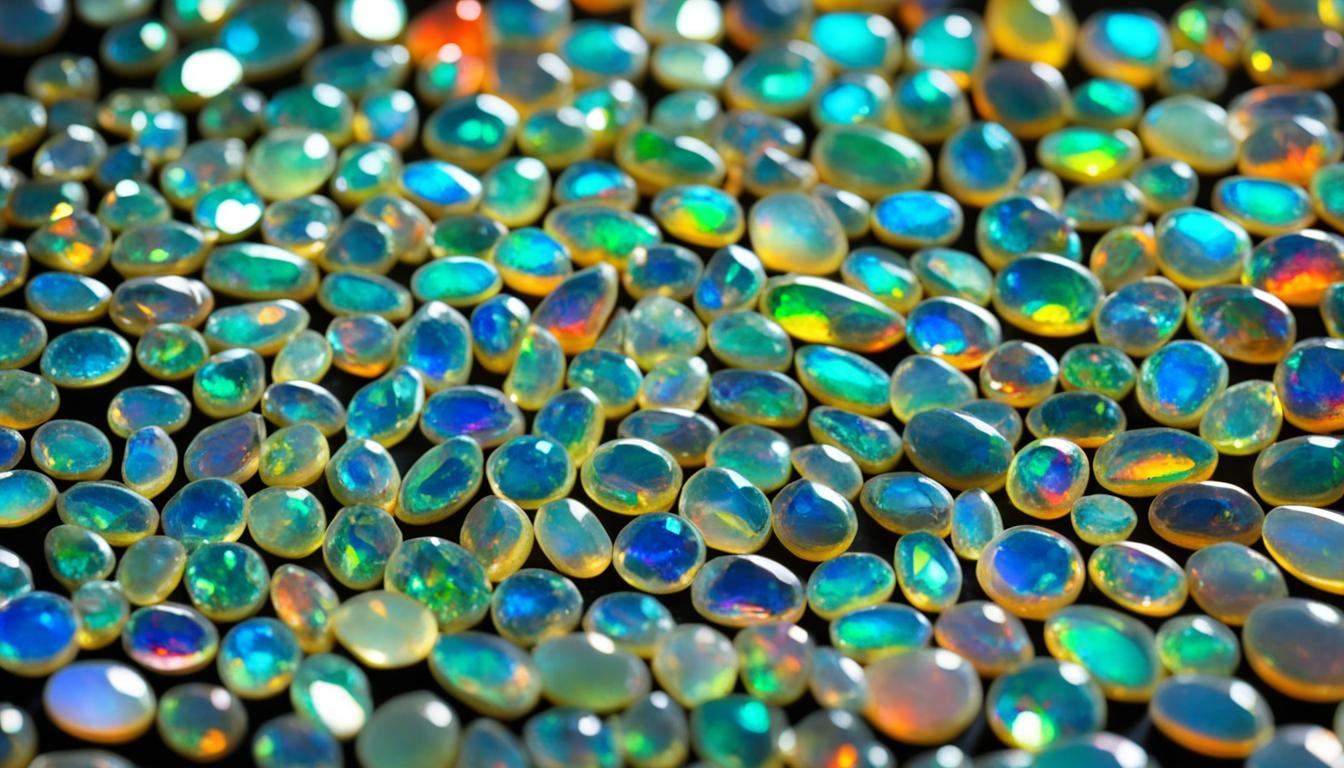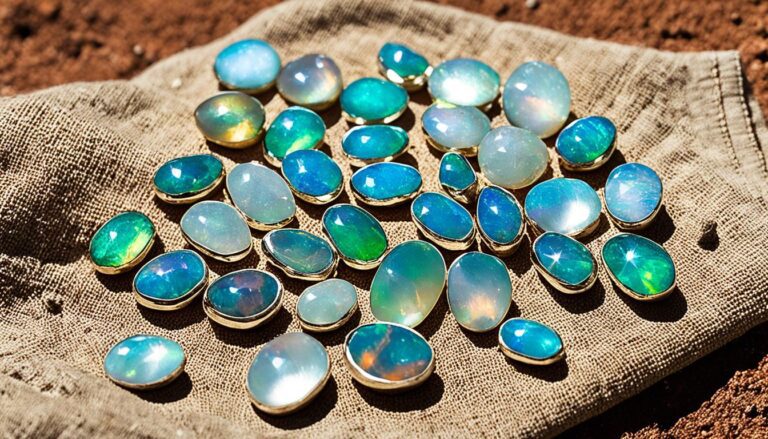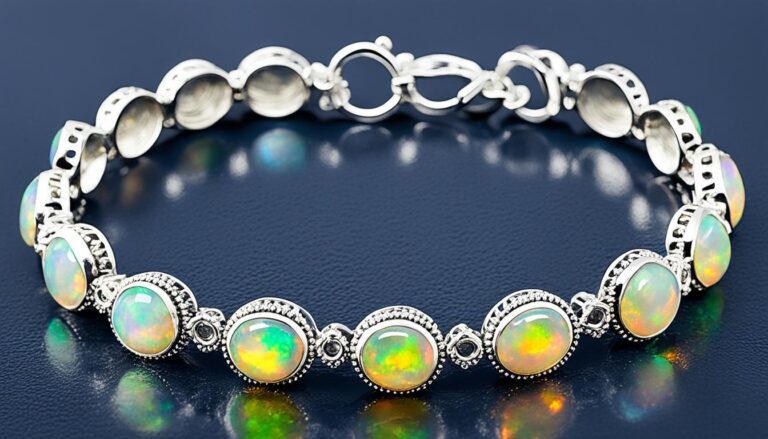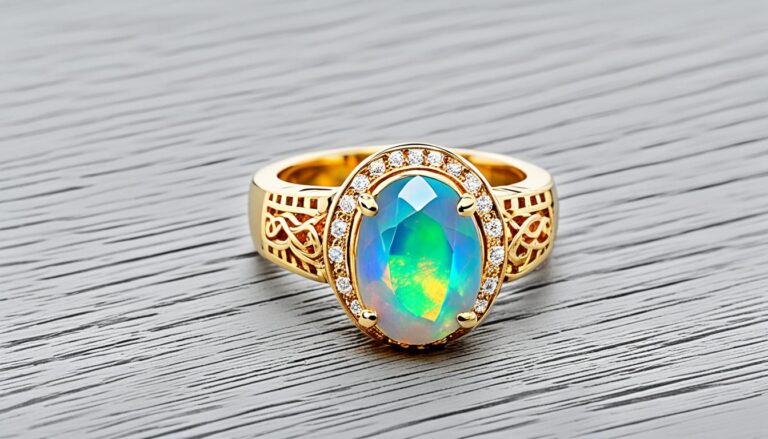How to Cut Ethiopian Opal
Discover the secrets of cutting Ethiopian Opal with our detailed guide. You’ll learn valuable tips and techniques to become a master. This guide is perfect for both experts and enthusiasts new to Opal cutting.
Ethiopian Opal cutting is much like cutting other Opals but with one key difference. Ethiopian Opal is Hyrdophane and it absorbs water. This makes choosing and sorting rough stones extra important.
We’ll walk you through every step, from testing rough stones for fractures to the final polish. You’ll also get tips and learn about the challenges of working with Ethiopian Opal.
Now, let’s start our journey into the fascinating world of Ethiopian Opal cutting. Brace yourself for an exciting adventure in bringing out its stunning colors.
Getting Started with Ethiopian Opal Cutting
Cutting Ethiopian Opal brings unique challenges. Its rough pieces may have hard sand and difficult shapes. It’s hard to cut, with only about 20% usable.
The first step in cutting is grinding off sand spots and removing concavities. This step can be tough as sand may run deep or cuts might be severe. Patience and care are essential for the best outcome.
Cutting Ethiopian Opal is different since it must first rehydrate. This helps reveal its stunning colors. So, it takes longer than cutting other Opals.
Positioning the stone right is vital as Ethiopian Opal’s color is often throughout. Sometimes, the back looks better as cutting continues. Skill and attention are crucial to show off the Opal’s beauty.
After cutting, the stone is rounded and polished for a dazzling finish. This makes the Ethiopian Opal shine even more.
While cutting Ethiopian Opal is challenging, it offers a big reward. With the right techniques, the finished gem can be truly striking.
Next Steps: The Cutting Process for Ethiopian Opal
The Cutting Process for Ethiopian Opal
When cutting Ethiopian Opal, certain steps are vital for great outcomes. We’ll look into how Ethiopian Opals are cut. This includes the steps to shape and polish these captivating gemstones.
The first part involves shaping the rough stone with a #220 diamond wheel. It helps make the gemstone look the way it’s supposed to. The Opal is carefully shaped, considering its unique features and any flaws.
Next, the stone is smoothed to remove roughness. Various Nova wheels from #280 to #3,000 are used. They make the surface of the Opal nice and smooth without scratches.
After smoothing, the Opal is polished. A wet leather wheel is coated with French cerium oxide for this. It reveals the gemstone’s shine and bright colors, creating a striking finish.
Crack Prevention and Identification
Ethiopian Opals can develop cracks as they absorb water during cutting. To avoid this, soaking the Opal and breaking it where it might crack is advised. This prevents future problems with the Opal.
Finding and addressing weak spots is also important while cutting. Sufficient pressure can reveal and help manage these spots, ensuring a smoother cutting process.
Benefits of Water in Opal Cutting
Using water as a lubricant is a popular cutting method for Ethiopian Opals. It helps dissipate heat and avoids stone damage. Water also improves the Opal’s color brightness, making the end result more beautiful.
Fracture Testing Ethiopian Opal Rough
Before cutting Ethiopian Opal rough, we must check for stability. Fracture testing ensures we don’t waste time on unstable stones. Two common tests are the blunt metal object and water methods.
The Blunt Metal Object Method
Use a blunt metal object and a rubber mallet for this test. Tap the Opal rough in suspicious areas to find any weak points or cracks. This tapping might break the stone but the pieces should stay together.
The Water Treatment Method
The water method is another way to test the stone’s strength. Pour cool to warm water over the rough stone. This exposes any hidden cracks. It’s important to dry the Opal thoroughly before proceeding with other steps.
Fracture testing Ethiopian Opal is crucial. It helps identify weak spots. This ensures the stone is safe to cut and polish, saving time and materials.
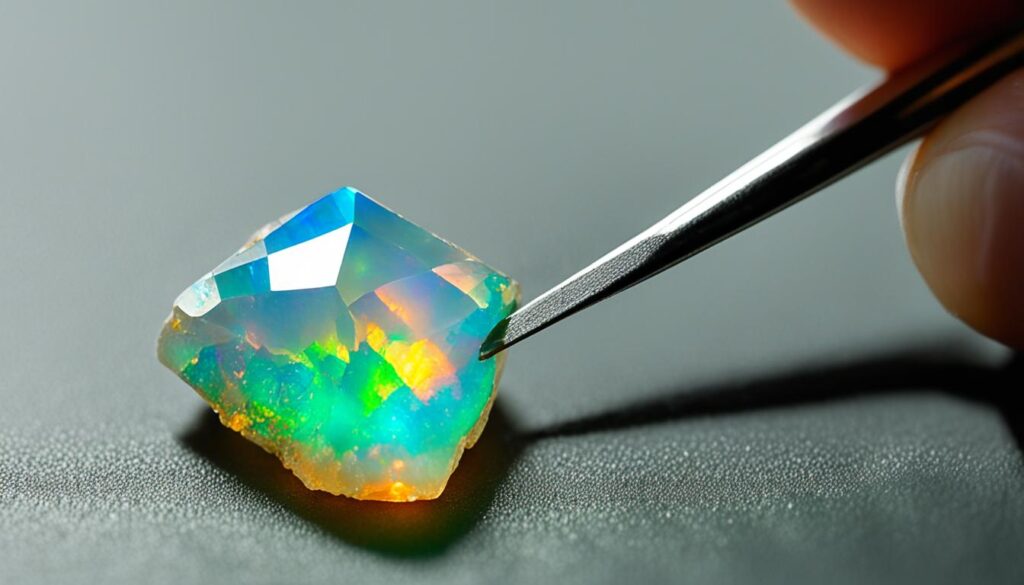
Understanding fracture testing is a vital first step. Next, we’ll look at how to secure the Opal for cutting. Setting it on a dop stick allows for precise cutting without damaging the stone.
Setting Ethiopian Opal on the Dop Stick
When it comes to cutting Ethiopian Opal, gluing it to a dop stick is the way to go. This is better than using hot jeweler’s wax. Gluing it makes sure the Opal stays put while cutting. The dop stick acts like a handle, making cutting more controlled and precise.
The Importance of Setting Ethiopian Opal on the Dop Stick
Using glue to set Ethiopian Opal on a dop stick offers lots of benefits when we cut it. Firstly, it gives a firm hold. This means the opal won’t move, allowing us to cut with great care.
Also, holding the Opal with the dop stick is very comfortable. It’s like an extra finger that helps us put the right amount of pressure. This is really important because Ethiopian Opal is unique and needs careful handling.
Glue vs. Wax for Setting Ethiopian Opal
While wax is common, it’s not good for Ethiopian Opal. Why? The heat can harm the Opal, changing its color or form. Gluing it keeps the Opal safe from the heat.
Choosing the right glue is crucial. Gem-safe and strong adhesives are the best pick. There are glues made just for gems. They keep the Opal secure on the dop stick as we cut and polish.
Using Water in Ethiopian Opal Cutting
When you cut Ethiopian Opal, water is a must, not just a choice. It acts as a lubricant, reduces heat, and safeguards the stone. This way, you get a better, smoother cut while keeping the Opal safe.
Water also brings out the Opal’s colors and clarity. As it flows over the stone, the true beauty and depth of the Opal shine. This makes the Opal look more spectacular.
Cutting with water produces superior results than cutting dry. It keeps the Opal stable and prevents cracks. This makes cutting more precise and controlled.
Using a lot of water is key in Opal cutting. A constant water flow keeps the stone cool and well-lubricated. This allows for the best cutting results.
Whether professional or hobbyist, water’s vital in cutting Ethiopian Opal. It serves as a lubricant, showcasing the gemstone’s beauty. So, use water and create amazing Opal jewelry.
Avoiding Excessive Pressure While Cutting Ethiopian Opal
Cutting Ethiopian Opal is a delicate task that requires precision. It’s key to watch how much pressure you apply. Too much force can harm the opal, making it less stable and lower in quality.
It’s vital to work gently, letting the Opal show you how to cut it. This method uses the Opal’s own features to decide on the best cutting way and depth. This helps keep the stone safe and makes it look even more stunning and special.
Pressing too hard might damage or break the Opal. Such harm can’t often be fixed and lowers the stone’s value. To prevent this, always use a light hand and remember how delicate the Opal is.
When cutting Ethiopian Opal, think of it as a mix of skill and care. Show respect to the stone and let its features direct your cut. In this way, you can make Opal pieces that really showcase its natural charm and lively colors.
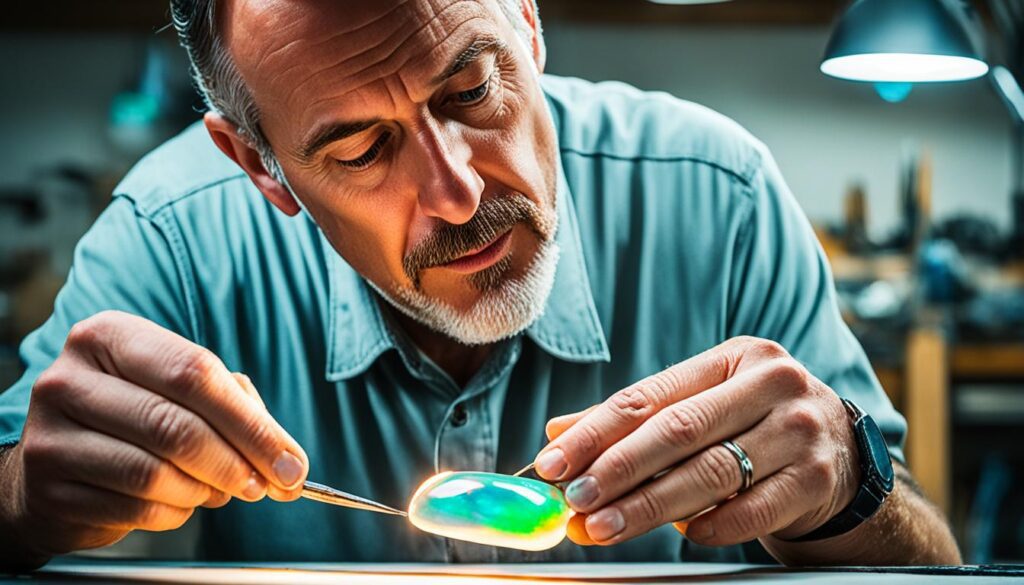
Shaping and Polishing Ethiopian Opal
Now, we turn to shaping and polishing Ethiopian Opal after cutting. Shaping means giving it a form, like a cabochon or faceted gem. The shape should enhance the Opal’s patterns and colors.
Polishing is key for a colorful Ethiopian Opal. It involves refining the surface slowly with finer abrasives. A high luster should be achieved. This way, the Opal’s beauty and colors shine brightly without any hindrance.
We use methods to boost Ethiopian Opal’s color play. By shaping and polishing skillfully, we make the stone reflect light in mesmerizing ways. Different cuts and finishes let us match the Opal to various jewelry styles and tastes.
Shaping Ethiopian Opal
We pay close attention to the Opal’s natural looks and patterns when shaping. This allows us to create special visual effects that bring out its beauty. Whether it’s cabochons or faceted gems, each shape highlights the Opal’s colors and patterns uniquely.
We shape the Opal with special tools carefully into the chosen form. Detail is key, as each cut changes how light interacts with the stone. Our goal is to bring out the Opal’s natural beauty, making it captivating and inspiring.
Polishing Ethiopian Opal
Polishing Ethiopian Opal is an art form that reveals its beauty. We take many steps to ensure the surface is smooth, removing flaws. The aim is to let the Opal sparkle brilliantly when light hits it.
Our polishing techniques bring out the Opal’s vivid colors and brilliance. Choosing the best polishing materials and methods is crucial. The final polish shows off the Opal’s lively colors and unique fire. This results in a gemstone that is truly eye-catching and beautiful.
Drying Out Ethiopian Opal After Cutting
Once Ethiopian Opal is cut and polished, it needs to dry completely. This step is vital for the Opal to stay strong over time.
Place the Opal in a warm, airy spot for drying after cutting. Keep it away from direct sun and sudden temperature changes. This can stress the Opal and harm it.
Avoiding quick drying or soaking up more moisture is key. Drying in an environment at 70-80°F (21-27°C) with 50-60% humidity is ideal.
Using the right drying methods keeps the Opal looking great and stable. Being patient during this process is crucial for your Ethiopian Opal’s future beauty.
Where to Shop for Ethiopian Rough Opal
Are you thinking about cutting Ethiopian Opal? You might wonder where to get rough material. There are many places to look for Ethiopian rough Opal.
Visit Reputable Gem and Mineral Shows
One way is to go to gem and mineral shows. Here, you can buy rough stones from suppliers. You get to see a lot of Ethiopian rough Opal and talk to experts. They can help you find the best stones.
Explore Online Platforms and Marketplaces
You can also check online websites and marketplaces. They sell various gemstones, including Ethiopian Opal. This way, you can see different options, compare prices, and look at quality. Always check the seller’s reputation and customer reviews. This ensures you buy from reliable people.
For Ethiopian rough Opal, knowing what to look for is key. Look for colors, patterns, and sizes you like. Whether you shop at shows or online, choose sellers who offer real, high-quality Opal. With the right information, starting your Opal-cutting journey will be thrilling and fun.
Conclusion
Cutting Ethiopian Opal needs attention and patience to reveal its beauty. Using water as a lubricant is key for a great result. Fracture testing, shaping, and polishing are crucial for its stability and color.
After the cutting, letting the Opal dry completely protects it. This step helps the gem last a long time. With the right tools and know-how, you can cut and make these precious gemstones.
Ready to dive into cutting Ethiopian Opal? Start your adventure with these wonderful gems. Find the gorgeousness within and relish turning them into stunning jewels. Learn the skills with love for the craft, and you can do wonders.

